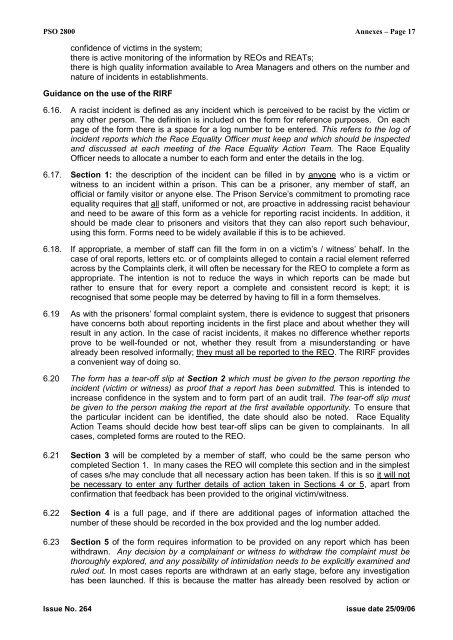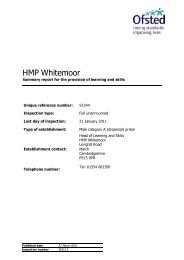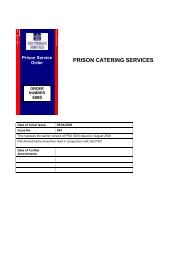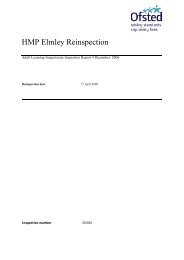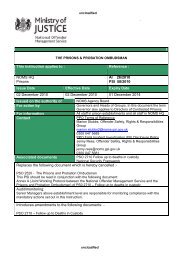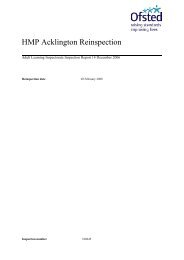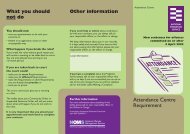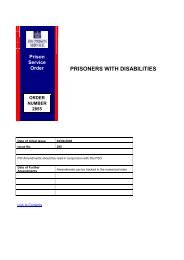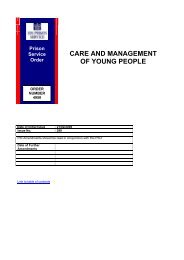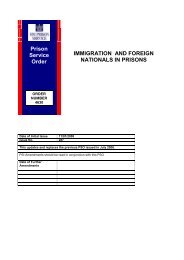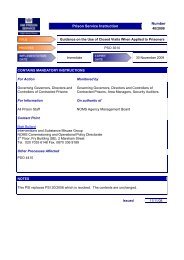PSO 2800 - Inside Time
PSO 2800 - Inside Time
PSO 2800 - Inside Time
- No tags were found...
You also want an ePaper? Increase the reach of your titles
YUMPU automatically turns print PDFs into web optimized ePapers that Google loves.
<strong>PSO</strong> <strong>2800</strong> Annexes – Page 17confidence of victims in the system;there is active monitoring of the information by REOs and REATs;there is high quality information available to Area Managers and others on the number andnature of incidents in establishments.Guidance on the use of the RIRF6.16. A racist incident is defined as any incident which is perceived to be racist by the victim orany other person. The definition is included on the form for reference purposes. On eachpage of the form there is a space for a log number to be entered. This refers to the log ofincident reports which the Race Equality Officer must keep and which should be inspectedand discussed at each meeting of the Race Equality Action Team. The Race EqualityOfficer needs to allocate a number to each form and enter the details in the log.6.17. Section 1: the description of the incident can be filled in by anyone who is a victim orwitness to an incident within a prison. This can be a prisoner, any member of staff, anofficial or family visitor or anyone else. The Prison Service‟s commitment to promoting raceequality requires that all staff, uniformed or not, are proactive in addressing racist behaviourand need to be aware of this form as a vehicle for reporting racist incidents. In addition, itshould be made clear to prisoners and visitors that they can also report such behaviour,using this form. Forms need to be widely available if this is to be achieved.6.18. If appropriate, a member of staff can fill the form in on a victim‟s / witness‟ behalf. In thecase of oral reports, letters etc. or of complaints alleged to contain a racial element referredacross by the Complaints clerk, it will often be necessary for the REO to complete a form asappropriate. The intention is not to reduce the ways in which reports can be made butrather to ensure that for every report a complete and consistent record is kept; it isrecognised that some people may be deterred by having to fill in a form themselves.6.19 As with the prisoners‟ formal complaint system, there is evidence to suggest that prisonershave concerns both about reporting incidents in the first place and about whether they willresult in any action. In the case of racist incidents, it makes no difference whether reportsprove to be well-founded or not, whether they result from a misunderstanding or havealready been resolved informally; they must all be reported to the REO. The RIRF providesa convenient way of doing so.6.20 The form has a tear-off slip at Section 2 which must be given to the person reporting theincident (victim or witness) as proof that a report has been submitted. This is intended toincrease confidence in the system and to form part of an audit trail. The tear-off slip mustbe given to the person making the report at the first available opportunity. To ensure thatthe particular incident can be identified, the date should also be noted. Race EqualityAction Teams should decide how best tear-off slips can be given to complainants. In allcases, completed forms are routed to the REO.6.21 Section 3 will be completed by a member of staff, who could be the same person whocompleted Section 1. In many cases the REO will complete this section and in the simplestof cases s/he may conclude that all necessary action has been taken. If this is so it will notbe necessary to enter any further details of action taken in Sections 4 or 5, apart fromconfirmation that feedback has been provided to the original victim/witness.6.22 Section 4 is a full page, and if there are additional pages of information attached thenumber of these should be recorded in the box provided and the log number added.6.23 Section 5 of the form requires information to be provided on any report which has beenwithdrawn. Any decision by a complainant or witness to withdraw the complaint must bethoroughly explored, and any possibility of intimidation needs to be explicitly examined andruled out. In most cases reports are withdrawn at an early stage, before any investigationhas been launched. If this is because the matter has already been resolved by action orIssue No. 264 issue date 25/09/06


